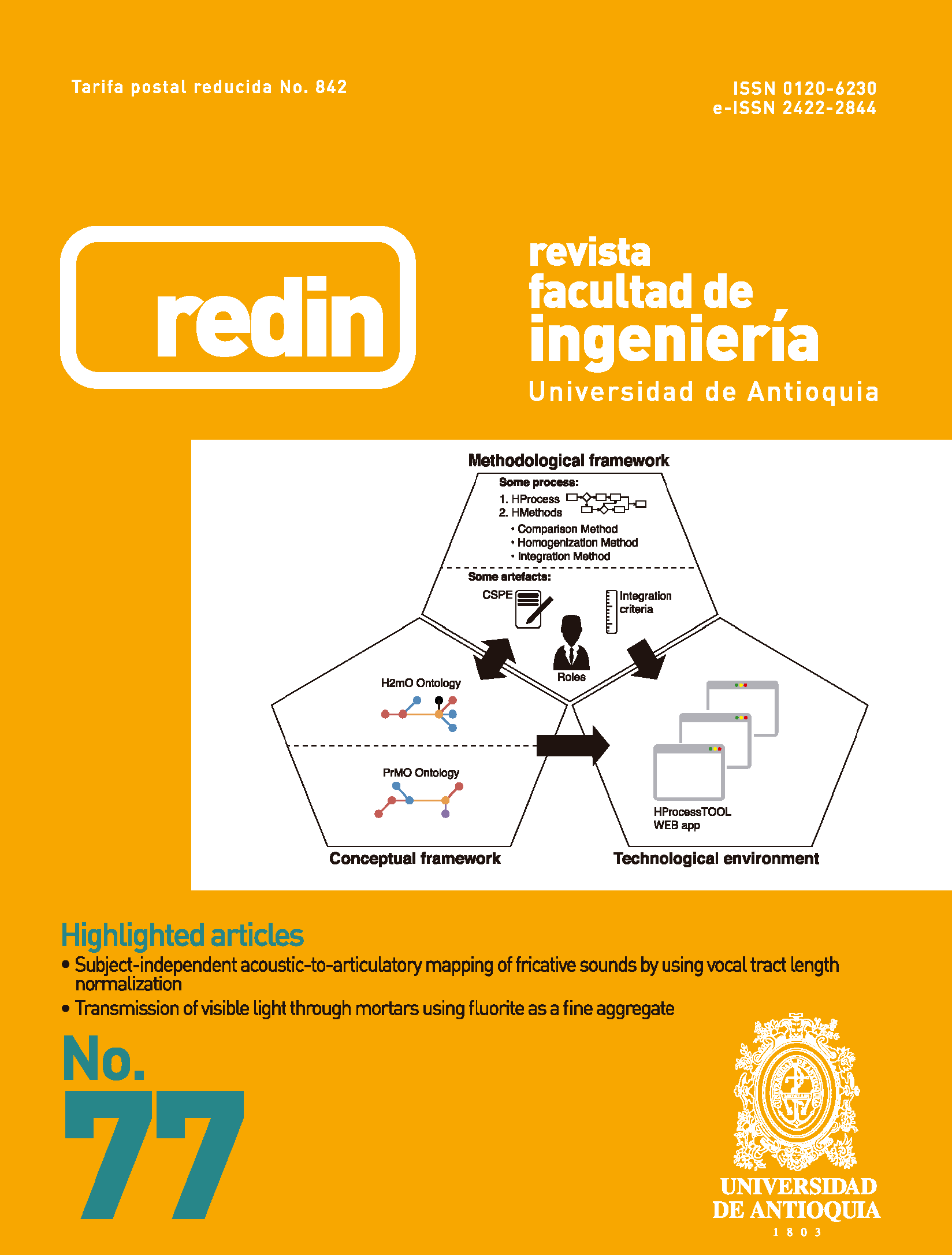Microcanal óptimo de grafito de alta conductividad térmica para el enfriamiento de componentes microelectrónicos
DOI:
https://doi.org/10.17533/udea.redin.n77a17Palabras clave:
disipadores de calor, mínima generación de entropía, optimización por enjambre de partículas unificado, grafito de alta conductividad térmica, microcanalesResumen
Este artículo describe el diseño de un microcanal rectangular óptimo, construido con grafi to de alta conductividad térmica (HTCG). Para simular el disipador de microcanales propuesto se utilizó el modelo de resistencia térmica total y el criterio de minimización de la generación de entropía. Para solucionar el problema de optimización, se utilizó el algoritmo de enjambre de partículas unifi cado (UPSO). Los resultados mostraron un efecto marcado al utilizar este conductor térmico, en comparación con materiales tradicionales (tales como aluminio), y utilizando aire y amoniaco gaseoso como fl uidos de trabajo. También se reporta el efecto relativo de las resistencias térmicas de constricción, de convección y del fl uido, sobre la resistencia térmica equivalente total. Como un ejemplo demostrativo del efecto causado al cambiar la naturaleza del refrigerante, se seleccionó un nanofl uido de dióxido de titanio. Se encontró que el número de Nusselt es perceptiblemente menor, cuando se utiliza un nanofl uido como refrigerante y cuando el material con que está construido el microcanal es HTCG.
Descargas
Citas
H. Fukushima, L. Drzal, B. Rook and M. Rich, “Thermal conductivity of exfoliated graphite nanocomposites”, J. Therm. Anal. Calorim., vol. 85, no. 1, pp. 235-238, 2006.
Hunan Chen Xiang Carbon Co., Ltd. (CX-CARBON), Products, 2014. [Online]. Available: http://www.cxcarbon.com/product/. Accessed on: Apr. 4, 2015.
S. Ghosh et al., “Extremely high thermal conductivity of graphene: Prospects for thermal management applications in nanoelectronic circuits”, Appl. Phys. Lett., vol. 92, no. 15, pp. 15-17, 2008.
S. Kim and L. Drzal, “High latent heat storage and high thermal conductive phase change materials using exfoliated graphite nanoplatelets”, Sol. Energy Mater. Sol. Cells, vol. 93, no. 1, pp. 136-142, 2009.
A. Tatami, M. Tachibana, T. Yagi, M. Akoshima and M. Murakami, “High Thermal Conductive Graphite Films from Thin Polymer Films”, in 15th International Heat Transfer Conference, Kyoto, Japan, 2014, p. 7.
C. Zhang, X. He, Q. Liu, S. Ren and X. Qu, “Fabrication and thermo-physical properties of graphite fl ake/ copper composites”, J. Compos. Mater., pp. 1-8, 2014.
M. Mochane and A. Luyt, “The effect of expanded graphite on the thermal stability, latent heat, and fl ammability properties of EVA/wax phase change blends”, Polym. Eng. Sci., vol. 55, no. 6, pp. 1255-1262, 2015.
Y. Li, “Research on Expanded Graphite/Nitrate HighTemperature Composite Phase Change Materials”, Appl. Mech. Mater., vol. 740, pp. 11-14, 2015.
J. Luo et al., “Numerical and experimental study on the heat transfer properties of the composite paraffi n/ expanded graphite phase change material”, Int. J. Heat and Mass Transf., vol. 84, pp. 237-244, 2015.
A. Adham, N. Mohd and R. Ahmad, “Optimization of an ammonia-cooled rectangular microchannel heat sink using multi-objective non-dominated sorting genetic algorithm (NSGA2)”, Heat and Mass Transf., vol. 48, no. 10, pp. 1723-1733, 2012.
A. Adham, N. Mohd and R. Ahmad, “Thermal and hydrodynamic analysis of microchannel heat sinks: A review”, Renew. Sustain. Energy Rev., vol. 21, pp. 614- 622, 2013.
J. Cruz, I. Amaya and R. Correa, “Optimal rectangular microchannel design, using simulated annealing, unifi ed particle swarm and spiral algorithms, in the presence of spreading resistance”, Appl. Therm. Eng., vol. 84, pp. 126-137, 2015.
W. Khan, M. Yovanovich and J. Culham, “Optimization of microchannel heat sinks using entropy generation minimization method”, in 22nd Annual IEEE Semiconductor Thermal Measurement and Management Symposium, Dallas, USA, 2006, pp. 78-86.
F. Incropera and D. DeWitt, Fundamentals of heat and mass transfer, 4th ed. New York, USA: John Wiley & Sons, 1996.
S. Kim and D. Kim, “Forced Convection in Microstructures for Electronic Equipment Cooling”, J. Heat Transfer, vol. 121, no. 3, p. 639-645, 1999.
K. Parsopoulos and M. Vrahatis, “Unifi ed Particle Swarm Optimization for Solving Constrained Engineering Optimization Problems”, in 1st International Conference on Advances in Natural Computation (ICNC), Changsha, China, 2005, pp. 582-591.
M. Kleiner, S. Kühn and K. Haberger, “High performance forced air cooling scheme employing microchannel heat exchangers”, IEEE Trans. on Components, Packaging and Manuf. Technol., A, vol. 18, no. 4, pp. 795- 804, 1995.
N. Hajialigol, A. Fattahi, M. Ahmadi, M. Qomi and E. Kakoli, “MHD mixed convection and entropy generation in a 3-D microchannel using Al2O3–water nanofluid”, J. Taiwan Inst. Chem. Eng., vol. 46, pp. 30-42, 2015.
Descargas
Publicado
Cómo citar
Número
Sección
Licencia
Derechos de autor 2015 Revista Facultad de Ingeniería Universidad de Antioquia

Esta obra está bajo una licencia internacional Creative Commons Atribución-NoComercial-CompartirIgual 4.0.
Los artículos disponibles en la Revista Facultad de Ingeniería, Universidad de Antioquia están bajo la licencia Creative Commons Attribution BY-NC-SA 4.0.
Eres libre de:
Compartir — copiar y redistribuir el material en cualquier medio o formato
Adaptar : remezclar, transformar y construir sobre el material.
Bajo los siguientes términos:
Reconocimiento : debe otorgar el crédito correspondiente , proporcionar un enlace a la licencia e indicar si se realizaron cambios . Puede hacerlo de cualquier manera razonable, pero no de ninguna manera que sugiera que el licenciante lo respalda a usted o su uso.
No comercial : no puede utilizar el material con fines comerciales .
Compartir igual : si remezcla, transforma o construye a partir del material, debe distribuir sus contribuciones bajo la misma licencia que el original.
El material publicado por la revista puede ser distribuido, copiado y exhibido por terceros si se dan los respectivos créditos a la revista, sin ningún costo. No se puede obtener ningún beneficio comercial y las obras derivadas tienen que estar bajo los mismos términos de licencia que el trabajo original.










 Twitter
Twitter